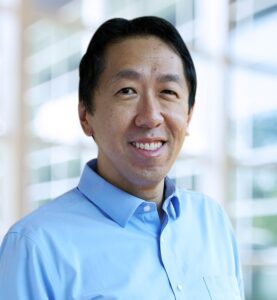Editor’s note: This article is part of an ongoing series in which Crunchbase News interviews active investors in artificial intelligence. Read previous interviews with Felicis, Battery Ventures, Bain Capital Ventures, Menlo Ventures, Scale Venture Partners, Costanoa, Citi Ventures and Sierra Ventures as well as highlights from more interviews done in 2023.
Google Brain and Coursera co-founder Andrew Ng’s AI Fund, launched in 2018, is a venture studio that focuses on building companies from scratch and investing in startups it had a hand in co-founding. The fund earlier this month announced a second fund of $190 million that includes a number of high-profile corporate investors.

On the heels of that announcement, we caught up with Ng on his experience building a venture studio with generative AI and how the approach of co-founding startups works.
“I’m personally involved in every single company we build,” said Ng. “I think a lot of VCs say they’re operators. But we’re operators to the point that we write code with our portfolio company.”
The AI Fund co-founds companies along with CEOs, actively participating in strategy, coding, customer discovery and more. Compared to its first fund — $175 million launched in 2018 — its second includes more corporate investors who provide valuable insights and access to specialized industries such as renewable energy.
Ng, who is also an adjunct professor in computer science at Stanford University, has been working in the artificial intelligence sector for the better part of 33 years, starting with an AI internship when he was 17. He founded the Google Brain team in 2011 and ran it for two years. He then co-founded Coursera in 2012, partnering with universities to expand access to education, and is still on the company’s board. Ng joined Chinese search engine Baidu in 2014 as its chief scientist, building its AI tooling. In 2017, he founded LandingAI, where he remains chairman, with a focus on visual AI solutions particularly relevant for manufacturing. That same year, he co-founded DeepLearning.AI for technical training in generative AI, and founded the AI Fund soon after.
The majority of his time now is spent on the AI Fund and DeepLearning.AI, which partners with many of the leading generative AI labs to build courses. With recent development in reasoning and multistep functions, Ng coined the broader term “agentic AI” to create a more inclusive understanding of “agentic systems that use design patterns such as reflection, tool use, planning, and multiagent collaboration to produce better results than zero-shot prompting.”
The AI Fund has 25 team members and has started investing from its second fund. It has co-founded around 35 portfolio companies so far, with some in stealth. Investors in the new fund include a number of corporate investors — AES, HP, Mitsui, Mitsubishi, QBE and Telus Ventures — as well as venture firms Sequoia Capital and NEA.
During our conversation, Ng spoke about a few portfolio companies, including Gaia Dynamics, which assists businesses with tariff compliance. The AI Fund started working with the company before the U.S. presidential election, anticipating tariffs and trade becoming more complex.
He also mentioned SkyFire AI, which works on drone deployment and operates a first responder program which was credited with saving a policeman’s life, and Profitmind, which helps retailers price products by automating comparisons with competitors to optimize pricing.
Tell me about the AI Fund and what’s different about it.
Ng: Unlike a traditional VC, our primary business activity is not to compete for deal flow. Our primary business activity is to identify promising startup ideas, validate the market need and the customer need. Then we recruit a CEO to work alongside us to build a company.
My team is there with the CEO, writing code, making customer discovery calls. We’re actively involved in debating company strategy, which features to prioritize over the next week, which customers to reach out to, and what’s the right pricing. We’re there to co-found the company alongside the CEO.
For fund 2, you have quite a few corporate investors, whereas for fund 1 not as many. Why that shift?
Ng: It turns out that a core part of a strategy is identifying valuable startup ideas. We really like working with corporate partners that are interested in building companies with us.
For example, one of our limited partners is AES, which is the largest manufacturer of renewable energy for corporate clients. They do a ton of the hyperscaler energy buildouts. AES will see applications in renewables. I don’t have access to large-scale solar and wind farms. And it turns out that there are many ways that AI can help with the operations of very large-scale energy infrastructure. It’s only by partnering with a company like AES, they can take us onto these large-scale solar and wind farms and let us play in a sector that otherwise we don’t have a right to play in.
It turns out a meaningful fraction of our startup ideas come from corporate partners that have spotted a market need, often in some sector of the economy, which is very large, very important but completely foreign to the typical consumer, or completely foreign to the typical AI engineer. I find that it’s been interesting how often we get to play in these spaces.
We think it’s wildly exciting, while no one else cares.
How does a project come together to become a company?
Ng: At any moment in time we have more ideas we could work on, by a large margin. So our team will look at a lot of these ideas and then decide which ones to affirmatively go forward on, mainly based on a technical assessment in terms of what AI technology can and cannot do, as well as the usual business assessment.
If we decide to move forward, we then recruit a CEO to be the major co-founder alongside us. We consider ourselves a minor co-founder and we very actively work with the CEO to build the company.
Our team is very AI-enabled. My CFO, my general counsel, my marketer — everyone knows how to code. We’re literally all builders.
What I’m finding is that with AI enablement, the team size needed to build something exciting is smaller, much smaller than it used to be. And the speed of iteration is also much faster than it used to be.
What does success look like for an AI Fund portfolio company?
Ng: Success would be the usual business metrics — revenue growth and eventual exit — so not that different from how early-stage investing typically views success.
What is very different is that we co-found companies. We use our resources, our technical expertise, our ability to recruit for the startups. We bring our resources to bear in a way that is more unique compared to traditional venture.
We run a full-cycle recruiting service, and we commit to helping our companies recruit their first few key executives. When a new startup that is not known reaches out to an executive, it’s difficult to get them to return a call. When someone reaches out from the AI Fund — because the AI Fund is known — and we endorse the company by saying we think this is really promising, we’re able to convince very skilled executives to seriously consider and often accept an opportunity.
So that’s actually one thing we do for our startups that we think is good in terms of helping them recruit. And then it helps us matchmake people that we know to be highly skilled executives into companies that we think are genuinely very promising.
What are the key early-skilled individuals you’re looking for?
Ng: When building AI startups, the deep understanding of the technology is very important. It’s hard to overstate that. I think the difference in performance between someone that really understands AI technology and people that have knowledge on top of it is a massive difference in performance.
It’s not the case where “they’re less good, but they’ll figure it out, it’ll just take a little bit longer.” It either works or doesn’t work. It’s about not spending six months going down a blind alley.
We try to make sure that the CEO and or CTO, at least, between them are really on top of technology, because a lot of the new opportunities are created by new technology that didn’t exist a year ago and makes something now possible that was not possible a year ago. Being close to or at that cutting edge, is absolutely critical in terms of having the right moment to moment instincts on what’s the right technology architecture. … Having that fine technical judgment is really important for avoiding missteps like that. And you just go so much faster.
What are the skillsets needed for a startup that wants to take this technology and apply it to a problem?
Ng: We interview a ton of AI engineers. I find that with generative AI two things are important. One is how you use AI in your own work, and the second is how your software uses AI. So the human uses AI and your software uses AI, and both of these are important. In terms of how a human uses AI, developers who know how to use AI coding assistants are dramatically faster than those who don’t.
I know there’s that stereotype out there, and there’s a lot of truth to that stereotype. There’s so many projects that would have taken me three months and six engineers — now I just build it myself on the weekend, or one of my engineers builds on the weekend. That velocity really is true.
I’ll share one other thing: There’s a stereotype of a new breed of AI native developers that’s really fast, and that is true. But I do see that the experienced engineers who are on top of AI are also much more productive than the inexperienced engineers who are on top of AI. So I think there’s this new stereotype of, let’s say, a fresh college grad who’s really fast with AI, and that stereotype is true. A fresh college grad, really, on top of AI is much faster than the traditional engineer with 10 years of experience who is not on top of AI. But that fresh college grad is also significantly outperformed by someone with 10 to 20 years of experience who is on top of AI.
I have the privilege to work with a number of them, executed at a velocity that I think the world had not seen two years ago. And it’s just magnificent how a very small team can execute stuff. Frankly, we build a thing in the morning, get user feedback in the evening, fix it at night. Then the next day we’re off to the next cycle. The velocity is just fantastic. I love it.
Any final thoughts?
Ng: AI technology is continuing to improve. We are seeing a lot of opportunities in visual AI, in building with the voice stack, and a lot of data reengineering efforts, empowering everyone to learn to code. It feels like AI is not one thing; it is many different things that are creating new opportunities.
Related Crunchbase list:
Illustration: Dom Guzman

Stay up to date with recent funding rounds, acquisitions, and more with the
Crunchbase Daily.
Source link
#Questions #Google #Brain #Founder #Andrew #Venture #Studio #Builds #Backs #Startups






























